Home | Tours | Trip Reports | News | Team | Calendar | Links | Contact | Store | Mailing List
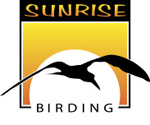 ANTARCTICA
ANTARCTICA
February 2008
Trip
Report
TRIP REPORT> PHOTO HIGHLIGHTS> PDF Report>(no photos)
Species Lists (PDF) : Buenos Aires>> Ushuaia>> Antarctic Cruise>>
LEADERS: Gina Nichol & Steve Bird

Days 1 & 2 - Friday & Saturday, February
7 & 8,
2008
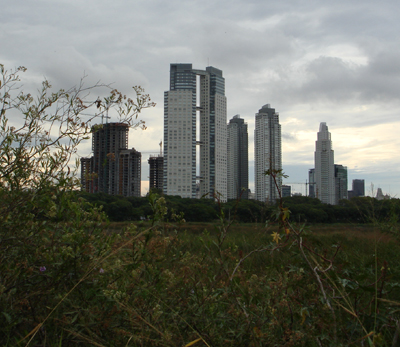 Most of the group left London around midday for our flight to Buenos Aires
via a short stop in Washington DC where we picked up Billie. After a
long flight we arrived at Buenos Aires and were soon on our way to our
hotel situated on the other side of town.
Most of the group left London around midday for our flight to Buenos Aires
via a short stop in Washington DC where we picked up Billie. After a
long flight we arrived at Buenos Aires and were soon on our way to our
hotel situated on the other side of town.
Once settled into our rooms we met up with our local guide, Lucas, and set off for an afternoon visit to the Costanera Sur. After getting off the bus the first bird we spotted was a Guira Cuckoo on top of a large tree. Birds came thick and fast as watched Great Egret fly over, a couple of Rufous Horneros walking around the grass, and an adult Chalk-browed Mockingbird feeding its large and obviously hungry chick. Moving on to the park proper we soon found ourselves overlooking a dried up marsh. Out on a muddy area, we spotted a group of Coscoroba Swans with some Southern Lapwings, Black-necked Stilts and the first of many Picazaro Pigeons. Several Chimango Caracaras flew around and we spotted a Long-winged Harrier, its distinctive jizz setting it apart from all other possible raptors in the area. We set up the scopes on the swans and proceeded with a more thorough scan. Fulvous Whistling-Ducks were found alongside Red-fronted Coots, Silver Teal, Lesser Yellowlegs. In the skies above were several Gray-breasted Martins, as well as a few Brown-chested Martins. A lone White-faced Ibis flew over and was later seen in a small creek with four Coscoroba Swans.
Back out on the mud we scoped a group of Brown-hooded Gulls, and turning
around we found we were being watched by a close male Yellow-billed 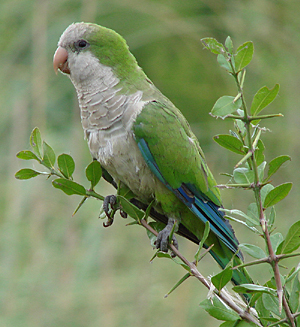 Cardinal.
Nearby we got good looks at a pair of Black-and-Rufous Warbling Flinches
in a thicket. A superb male Glittering-bellied Emerald sat perched on
a bare twig giving great views. Continuing our leisurely walk we found
a Snake-necked Turtle crossing the track in front of us. From a viewing
platform we got to see a Yellow-winged Blackbird fly into the reeds and
we scrutinized the first of many Rufous-bellied Thrushes. A juvenile
Creamy-bellied Thrush was a good find near some Rufous
Horneros and then our first Brazilian Guinea Pigs appeared, after which
they seemed to be everywhere. Lucas enticed a smart looking Narrow-billed
Woodcreeper to show itself and we all enjoyed very good close views.
Several distant Cattle Tyrants were a struggle to see compared with a
showy Bay-winged Cowbird perched out on a bare tree. Moving on we overlooked
a more open area where we had some very close perched Monk
Parakeets and several stunning Fork-tailed Flycatchers. Next up were the first
of many Double-collared Seedeaters and a brief Black-billed Cuckoo.
Some Saffron Finches were found with more Double-collared Seedeaters
and some excellent views of a Masked Yellowthroat. A distant Green-barred
Woodpecker allowed scope views as it fed on the ground and it stayed
until we walked past it within a few feet. Other birds in the same spot
included Spectacled Tyrant, White-rumped Swallows, and our first Crested
Cardinal. A little further on more Green-barred Woodpeckers allowed exceptional
views.
Cardinal.
Nearby we got good looks at a pair of Black-and-Rufous Warbling Flinches
in a thicket. A superb male Glittering-bellied Emerald sat perched on
a bare twig giving great views. Continuing our leisurely walk we found
a Snake-necked Turtle crossing the track in front of us. From a viewing
platform we got to see a Yellow-winged Blackbird fly into the reeds and
we scrutinized the first of many Rufous-bellied Thrushes. A juvenile
Creamy-bellied Thrush was a good find near some Rufous
Horneros and then our first Brazilian Guinea Pigs appeared, after which
they seemed to be everywhere. Lucas enticed a smart looking Narrow-billed
Woodcreeper to show itself and we all enjoyed very good close views.
Several distant Cattle Tyrants were a struggle to see compared with a
showy Bay-winged Cowbird perched out on a bare tree. Moving on we overlooked
a more open area where we had some very close perched Monk
Parakeets and several stunning Fork-tailed Flycatchers. Next up were the first
of many Double-collared Seedeaters and a brief Black-billed Cuckoo.
Some Saffron Finches were found with more Double-collared Seedeaters
and some excellent views of a Masked Yellowthroat. A distant Green-barred
Woodpecker allowed scope views as it fed on the ground and it stayed
until we walked past it within a few feet. Other birds in the same spot
included Spectacled Tyrant, White-rumped Swallows, and our first Crested
Cardinal. A little further on more Green-barred Woodpeckers allowed exceptional
views.
This was proving to be an excellent afternoon of birding as a male Golden-billed Saltator called from the top of a bush. Opposite in a smaller bush, we got to grips with a showy White-crested Tyrannulet. The trees approaching a huge river were now littered with Picazuro Pigeons. Down by the riverside we took a short rest while scoping a distant Kelp Gull, and watching birds running around our feet including Eared Doves, Saffron Finch, Chalk-browed Mockingbirds, Tropical Kingbird, and then a flyby Neotropic Cormorant.
On the return trail, we came across a pair of Green-barred Woodpeckers performing a most amazing display. They sat perched a few inches away from each other and then frantically shook their heads back and forth while constantly calling. In a small scrubby gull,y we watched a pair of Bran-colored Flycatchers and two Short-billed Elaenias. Ahead of us a Giant Woodrail was spotted walking across the trail and thankfully we all got to see it before it slipped off into the undergrowth. A short board walk allowed us to get close views of a Freckle-breasted Thornbird and then, to finish off a superb walk, we watched lots of Glittering-bellied Emeralds feeding on flowers alongside the track. We had wonderful flight views of a Rufescent Tiger-Heron and the grand finale of a male Scarlet-headed Blackbird flying above the reeds. Just before we got back to our bus we saw a few Brown-chested Martins perched on some telephone wires allowing far better views than in flight earlier. Driving back into town we were soon at our hotel, where we later enjoyed dinner and a run through of the birds we had seen.
Day 3 - Saturday, February 9, 2008
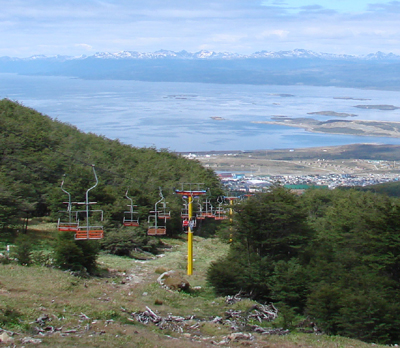 This morning we were up earlier for our transfer to Buenos Aires International
Airport where we took a smooth flight to the most
southerly town in Argentina and in the world – Ushuaia. After being
picked up and transferred to our hotel, we met outside and took a quick
look from the hotel grounds and notched up species including two young
Southern Caracaras perched in a bare tree, Chilean Swallows flying low
overhead and a couple of bright red Long-tailed Meadowlarks perched on small bushes in a field near the hotel. A Black-chested Buzzard Eagle appeared and circled high
overhead while some of the group added the first Austral Thrush. Our local guide Marcello came by took us up to
the Martial Glacier. We boarded the small chairlift which took us slowly
up above the tree line. Once up, we followed a stream until we reached
a more open area. Here we scanned the mossy ground where we soon found
Bar-winged Cinclodes, many Rufous-collared Sparrows, a female Yellow-bridled
Finch, and the first of twenty or more Dark-faced Ground Tyrants. We
spotted a pair of Black-chinned Siskins and also an Ochre-naped
Ground-Tyrant. On our way back to the chair lift and a small
group of birds were spotted including Thorn-tailed Rayadito and a few
White-crested Elaenias. Returning back to our warm hotel, some of the
group took advantage of the extended daylight to walk around the area.
A few more birds were spotted and a Muskrat was seen swimming across
a small stream. In the evening we went into town to a small local restaurant
which served up some delicious food accompanied by excellent service.
This morning we were up earlier for our transfer to Buenos Aires International
Airport where we took a smooth flight to the most
southerly town in Argentina and in the world – Ushuaia. After being
picked up and transferred to our hotel, we met outside and took a quick
look from the hotel grounds and notched up species including two young
Southern Caracaras perched in a bare tree, Chilean Swallows flying low
overhead and a couple of bright red Long-tailed Meadowlarks perched on small bushes in a field near the hotel. A Black-chested Buzzard Eagle appeared and circled high
overhead while some of the group added the first Austral Thrush. Our local guide Marcello came by took us up to
the Martial Glacier. We boarded the small chairlift which took us slowly
up above the tree line. Once up, we followed a stream until we reached
a more open area. Here we scanned the mossy ground where we soon found
Bar-winged Cinclodes, many Rufous-collared Sparrows, a female Yellow-bridled
Finch, and the first of twenty or more Dark-faced Ground Tyrants. We
spotted a pair of Black-chinned Siskins and also an Ochre-naped
Ground-Tyrant. On our way back to the chair lift and a small
group of birds were spotted including Thorn-tailed Rayadito and a few
White-crested Elaenias. Returning back to our warm hotel, some of the
group took advantage of the extended daylight to walk around the area.
A few more birds were spotted and a Muskrat was seen swimming across
a small stream. In the evening we went into town to a small local restaurant
which served up some delicious food accompanied by excellent service.
Day 4 - Sunday, February 10, 2008
After breakfast we met Marcello and set off for some local birding. Within
minutes we spotted three 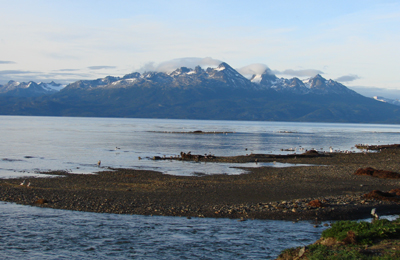 Southern Lapwings and a Thorn-tailed
Rayadito. Down by the shoreline, we found Austral Negrito
and then great numbers of birds scattered among the rocks and out into
the open water. Numerous Kelp and Dolphin Gulls were interspersed with
Kelp Geese, Crested Ducks, a few Blackish and Magellanic Oystercatchers,
Ashy-headed Geese, and a pair of Flying Steamer Ducks with chicks. Out
in the bay we spotted Southern Giant Petrels and some Sooty Shearwaters and beyond these we could see many Black-browed Albatrosses. A Chilean
Skua then flew close over head and we enjoyed some even closer views
of the Giant Petrel. A distant Andean Condor never stayed on view long
enough for everyone to see, but a Dark-bellied Cinclodes was quite the
opposite and allowed superb close views. Further out in the bay, we spotted
several Flightless Steamer Ducks.
Southern Lapwings and a Thorn-tailed
Rayadito. Down by the shoreline, we found Austral Negrito
and then great numbers of birds scattered among the rocks and out into
the open water. Numerous Kelp and Dolphin Gulls were interspersed with
Kelp Geese, Crested Ducks, a few Blackish and Magellanic Oystercatchers,
Ashy-headed Geese, and a pair of Flying Steamer Ducks with chicks. Out
in the bay we spotted Southern Giant Petrels and some Sooty Shearwaters and beyond these we could see many Black-browed Albatrosses. A Chilean
Skua then flew close over head and we enjoyed some even closer views
of the Giant Petrel. A distant Andean Condor never stayed on view long
enough for everyone to see, but a Dark-bellied Cinclodes was quite the
opposite and allowed superb close views. Further out in the bay, we spotted
several Flightless Steamer Ducks.
Back aboard the bus we drove to an area near the airport and here we scanned a section of beach and found more Dark-bellied and Bar-winged Cinclodes, and several Southern Caracaras. On a small pool across the road, we had two Speckled Teal. A Correndera Pipit was seen only in flight and an Upland Goose fed among the long grass. Back on the beach, there were several Austral Negritos and shorebirds that included mostly Baird’s Sandpipers and a single White-rumped Sandpiper. Both Chilean Skua and an adult Black-chested Buzzard Eagle flew overhead and gave superb views.
We then moved off to collect our rental jackets ready for the start of our Antarctica Cruise in the afternoon. Once we had sorted this out, we headed for a small estuary mouth where we were soon scoping lots of Kelp and Dolphin Gulls mixed with Southern Caracaras and Crested Ducks. After some searching a sub-adult White-throated Caracara was found and we enjoyed studying this bird for several minutes. In the sea, several Southern Giant Petrels sat around lazily in small groups. Gina then spotted a very dark looking Caracara which we immediately trained our scopes and binoculars on. It was only 100 yards away and, although a very tatty individual, we were delighted to identify this bird as a Striated Caracara, a scarce visitor to this area and an excellent bird to see. We studied the bird on the ground and then it took flight showing very dark plumage, no pale tips or edges to any of the flight feathers, a whitish tip to tail and large amount of grayish white around the bill up to and in front of the eye. We were fortunate to be able to scrutinize this bird and were all pleased at add it to our list.
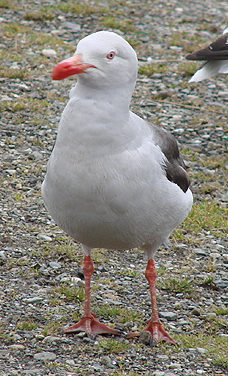 While all this was going on a South Polar
Skua circled low overhead accompanied by lots of Chilean Skuas. Moving
on to a large rubbish dump we got to see several adult and immature White-throated
Caracaras. It was nearing lunch time so we drove to a waterfront lodge
and took a leisurely meal. We were soon distracted when
a distant Andean Condor put in an appearance and had us run outside and
set our scopes on it. After lunch, a short walk into the nearby woods
produced a small flock of birds that included a family of Patagonian Sierra-Finches,
Thorn-tailed Rayaditos, and Black-chinned Siskins.
While all this was going on a South Polar
Skua circled low overhead accompanied by lots of Chilean Skuas. Moving
on to a large rubbish dump we got to see several adult and immature White-throated
Caracaras. It was nearing lunch time so we drove to a waterfront lodge
and took a leisurely meal. We were soon distracted when
a distant Andean Condor put in an appearance and had us run outside and
set our scopes on it. After lunch, a short walk into the nearby woods
produced a small flock of birds that included a family of Patagonian Sierra-Finches,
Thorn-tailed Rayaditos, and Black-chinned Siskins.
After a last few minutes in the town of Ushuaia and some close looks at Dolphin Gulls, it was now time to head toward the port to board our ship “Ushuaia”. This perfectly sized ship was our home for the next eleven days. Once aboard we settled in and before long we set sail. We hadn’t even left port when two Magellanic Penguins were spotted beside the dock. On the way out of the harbor, we saw many South American Terns, Southern Giant Petrels, and a constant procession of King Shags. We had already found a perfect place to view from which was out of the wind and over the next few hours until 10.30 pm we scoured the seas for anything that moved. Black-browed Albatrosses soon appeared giving wonderful close views and at one point a flock of nearly 70 were seen on the sea together. More Giant Petrels were seen along with Chilean Skuas, countless South American Terns, and several groups of Magellanic Penguins. Later we did find a few Imperial Shags in association with their darker faced “King” cousins. As darkness fell, so did we, tired and ready for tomorrow.
Day 5 - Monday, February 11, 2008
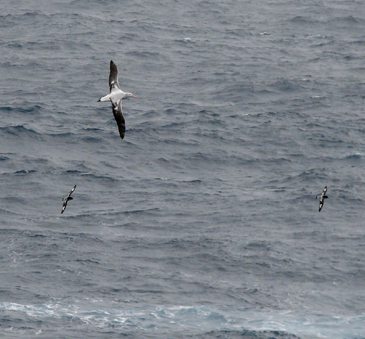 Most of us were up early and in position beside the bridge from where we
could comfortably scan the fairly calm open ocean. We were in the dreaded
Drake Passage and were soon watching adult Black-browed Albatrosses glide
effortlessly past us. A Northern Giant Petrel appeared and came close
enough that we could distinguish its dark, orange tipped bill and even
its pale eye. Breakfast was then served, and as some of the group were
finishing off, others had already gone on deck and were thrilled and
excited to be watching their first Wandering and Southern Royal Albatrosses.
These huge birds can’t help but thrill and we were all in admiration
as they arced and turned with such ease and then came alongside the ship
like some sort of light aircraft. It wasn’t long before our first
White-chinned Petrel and Wilson’s Petrels crossed the wake. To
see the tiny Wilson’s dwarfed by a Wandering
Albatross cruising
low over its head, was quite a sight. Several Sooty Shearwaters appeared
and allowed comparisons at distance with the all dark looking White-chinned
Petrels, the later very distinct by it thick pale bill, and not its white-chin
which is just about impossible to see unless very close. As the day went
on we encountered these birds over and over again allowing
everyone to get familiar with there flying patterns and with the albatrosses
in their many different plumage variations. Both species of Giant Petrel
could also be compared.
Most of us were up early and in position beside the bridge from where we
could comfortably scan the fairly calm open ocean. We were in the dreaded
Drake Passage and were soon watching adult Black-browed Albatrosses glide
effortlessly past us. A Northern Giant Petrel appeared and came close
enough that we could distinguish its dark, orange tipped bill and even
its pale eye. Breakfast was then served, and as some of the group were
finishing off, others had already gone on deck and were thrilled and
excited to be watching their first Wandering and Southern Royal Albatrosses.
These huge birds can’t help but thrill and we were all in admiration
as they arced and turned with such ease and then came alongside the ship
like some sort of light aircraft. It wasn’t long before our first
White-chinned Petrel and Wilson’s Petrels crossed the wake. To
see the tiny Wilson’s dwarfed by a Wandering
Albatross cruising
low over its head, was quite a sight. Several Sooty Shearwaters appeared
and allowed comparisons at distance with the all dark looking White-chinned
Petrels, the later very distinct by it thick pale bill, and not its white-chin
which is just about impossible to see unless very close. As the day went
on we encountered these birds over and over again allowing
everyone to get familiar with there flying patterns and with the albatrosses
in their many different plumage variations. Both species of Giant Petrel
could also be compared.
Our first Prion defied identification as it was all too brief and salient features could not be seen with any certainty. The Cape Petrel caused no such headaches and we enjoyed superb looks at it continually followed the ship. A Southern Royal Albatross gave incredible views alongside many Wandering before it was time for lunch and a short siesta. Back on deck we were soon back into a wealth of birds. In addition to the species we could now consider regular, we found a couple of Black-bellied Storm-Petrels. The two birds flew back and forth with Wilson’s Petrels and once again all the important features of both species could be seen well.
The next bird of real interest was a “white phase” Southern Giant Petrel, this particular color variation restricted only to this one of the two Giant Petrel species. As the rest of the afternoon and evening passed by we simply enjoyed the spectacle of all these birds. Among the Wandering Albatrosses, we separated a couple of Antipodean Albatross showing dark caps, collars, and under tail coverts. More Petrels and more Prions appeared (this time specifically identified as Antarctic Prion). With brief views of an unusual looking petrel from the lounge we managed to see two more at sea and the combination of obvious white belly, dark hood, dark under wing, dark upper wing, we confirmed this species to be Atlantic Petrel - great bird that is quite unusual in these waters. Sebastian, our expedition leader for the ship, announced that this was an unusually calm passage for the Drake Channel, but by late afternoon changed to a fair swell which by the evening dinner time saw cutlery, tables and people shifting across the dining room floor. It was certainly time for bed and this we did ready to see what tomorrow would bring.
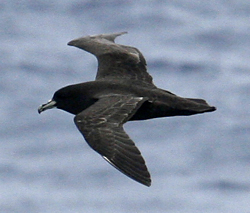 Day 6 - Tuesday, February 12, 2008
Day 6 - Tuesday, February 12, 2008
This morning started reasonably calm with lesser numbers of yesterdays
birds still following the ship. The Wandering Albatrosses seemed to be
mainly adults and Wilson’s Petrels were now numerous. There were
many Cape Petrels swirling around in majestic flocks and it wasn’t
long before we spotted our first of four Soft-plumaged Petrels. A few
Black-browed Albatross, White-chinned Petrels, and Black-bellied
Storm Petrel were also seen. We also saw a couple of
unidentified distant whale “blows” and some Antarctic Fur
Seals. Numbers of birds increased as the morning progressed and many
Chinstrap Penguins were seen porposing through the wave tops. As lunch
time approached we came across our first huge iceberg, with many
more to come.
After a safety and procedure briefing, we boarded our
zodiacs and headed for shore. What an amazing arrival on a small beach
where Chinstrap and Gentoo Penguins seemed to be everywhere and totally
unconcerned that we had arrived! A short walk around the edges of the
colony allowed everyone to get fabulous views and endless photographs.
The Gentoos had nests with chicks from the just hatched to others that were larger and downy gathered in creches being watched by a few adults. We made our
way past the Chinstraps and Gentoos where there were several menacing
Antarctic Skuas waiting for a chance to snatch a meal. The sheer spectacle and surrounding scenery made for
an incredible visit to our first island. We continued along the beach
where penguins played in the surf and ancient Whale bones littered the
high tide line. Several Snowy Sheathbills were spotted either flying
over or running around amongst the hoards of penguins. Antarctic 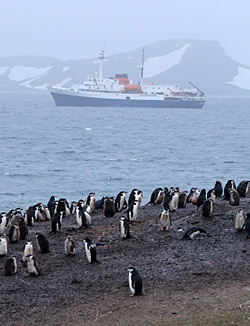 Shags
sat out on the rocks and a group of Southern Giant Petrels slowly swam
ashore where we got fantastic close views including an all ”White” phase
which is generally called “Nellie”.
Shags
sat out on the rocks and a group of Southern Giant Petrels slowly swam
ashore where we got fantastic close views including an all ”White” phase
which is generally called “Nellie”.
Watching the penguins we enjoyed family squabbles, adults feeding young, young trying to get parents to feed them, young chasing adults, and just about every activity you could think of. As we returned back to the landing site, we saw and got close to a Snowy Sheathbill, and for some of our group we got to see a huge Leopard Seal close into shore. Everyone content with this excellent shore excursion, we returned to the ship and then set sail across the Antarctic Sound. As we were about to sit down for dinner a Humpback Whale was spotted ahead of the ship. We got to the bow as quick as possible and enjoyed superb views of several animals “blowing”, “waving pectoral fins”, “half breaching” and surfacing enabling superb views of the upper body and “dorsal fin”.
As if this wasn’t enough, as soon as we got back to the dining room we were alerted to another sighting. This time we got to see blows and surfacing from a small group of about five animals which initially looked like Fin Whales, a species with which we are very familiar. However, the dorsal fins were particularly long and more vertical than Fin Whales, this feature together with blow height and shape, and the animal's behavior led us to re-identify them as Sei Whales, a species we are less familiar with but very happy to see well. After dinner we spent a little more time sea-watching which produced a few more Humpback Whales. After a fantastic day, we retired anticipating more adventures tomorrow.
Day 7 - Wednesday, February 13, 2008
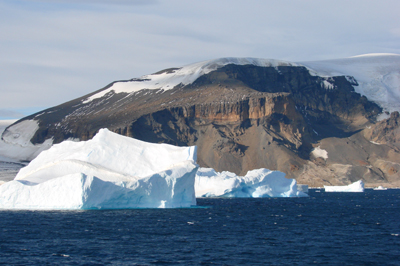 This morning we were up early to see a fabulous sunrise in a truly spectacular
area. Surrounded by icebergs, and the rocky mass of Brown
Bluff, we were in the midst of the classic Antarctica landscape. Simply fantastic! The bird life
was sparse but still included Southern Giant Petrels, Cape Petrels, a
few Wilson’s Petrels, and Antarctic Terns.
This morning we were up early to see a fabulous sunrise in a truly spectacular
area. Surrounded by icebergs, and the rocky mass of Brown
Bluff, we were in the midst of the classic Antarctica landscape. Simply fantastic! The bird life
was sparse but still included Southern Giant Petrels, Cape Petrels, a
few Wilson’s Petrels, and Antarctic Terns.
After breakfast we approached the tall cliffs of Brown Bluff where there was an incredible increase in wind speed. It went from almost calm to 50 knots, a well known atmospheric phenomenon of Antarctica called a Katavetic Wind. After a investigation launch, it was found to be too dangerous and windy on the shore, so this landing had to be cancelled. We scanned the rock face and struggled to see what looked like very distant Snow Petrels high over the sheer cliffs. Plenty of Cape Petrels were noted and Southern Giant Petrels including ‘white phase’ birds also patrolled the immense rock face. Heading away from here we passed by two other islands where we got better views of several Snow Petrels including two that flew very low allowing what could only be considered as good views. Flocks of Cape Petrels appeared and the occasional Antarctic Tern slowly flapped its way across the picture postcard scenery.
 Approaching another island, Gina spotted a Snow
Petrel heading
straight toward our ship. In perfect conditions we were amazed when it
came right up to the bow and went around the side of the ship where we
enjoyed incredible views of this most enigmatic bird. This bird was high
on our list to see and we could not have asked for a better show. It took
us a while to get over this but we soon settled in to watching numerous
Adelie Penguins porposing through the sea. The wind was not abating so we set off toward Paulet Island where the conditions were fine for us to
make a shore landing. We were soon on a long pebbly beach surrounded by
thousands of Adelie Penguins of all ages and hair styles. Among the profusion
of penguins that lined the beach and continued way up into the hills we
pick out several Antarctic Shags, Brown Skuas, South Polar Skua, and Antarctic
Fur Seals. We then set off back to the South Shetland Islands passing spectacular
icebergs and several more Snow Petrels bringing our total for this superb
species up to 11. Continuing on, the scenery became dominated by huge tabular
icebergs as well as many others of varying sizes and every shape imaginable.
Approaching another island, Gina spotted a Snow
Petrel heading
straight toward our ship. In perfect conditions we were amazed when it
came right up to the bow and went around the side of the ship where we
enjoyed incredible views of this most enigmatic bird. This bird was high
on our list to see and we could not have asked for a better show. It took
us a while to get over this but we soon settled in to watching numerous
Adelie Penguins porposing through the sea. The wind was not abating so we set off toward Paulet Island where the conditions were fine for us to
make a shore landing. We were soon on a long pebbly beach surrounded by
thousands of Adelie Penguins of all ages and hair styles. Among the profusion
of penguins that lined the beach and continued way up into the hills we
pick out several Antarctic Shags, Brown Skuas, South Polar Skua, and Antarctic
Fur Seals. We then set off back to the South Shetland Islands passing spectacular
icebergs and several more Snow Petrels bringing our total for this superb
species up to 11. Continuing on, the scenery became dominated by huge tabular
icebergs as well as many others of varying sizes and every shape imaginable.
Day 8 - Thursday, February 14, 2008
We awoke to another spectacular start to the day with the majestic backdrop
of Livingstone Island. With the wind speed too high to make a landing
on Livingstone, an immediate decision was made to change the itinerary
and visit a small island called “Half Moon”. Several Humpback
Whales livened our journey. As we approached a quiet bay, we spotted
a whale “breach” in the bay. It did this four
or five times allowing us not only fantastic views but also a chance
to take photographs of what turned out to be a Dwarf Minke Whale. Dressed
for an excursion we were whisked ashore in the zodiacs where an awaiting
entourage of Gentoo Penguins looked pleased to see us. A walk over the
small hill found us several Antarctic Terns and Snowy Sheathbills started
to appear from all angles. We then spotted a nest under a huge rock and
watched two Sheathbill chicks waiting to be fed. On the
other side of the hill we found some Southern Giant Petrels resting
while Wilson’s Petrels flew out of the cliffs. A Leopard
Seal appeared along the edge of the beach, obviously on patrol in search of penguins especially the chicks and immature
birds. A short walk along the beach here brought us to a huge whale bone,
a reminder of past days of whaling in Antarctica.
Back on board, we set off toward our next destination of Deception Island, a volcanic island. We approached the steep vertical cliffs and entered the caldera. As our ship navigated through the entrance, we were visited by flocks of Cape Petrels looking fabulous against the back drop of the dark cliffs. The waters inside were calm, so we anchored off shore and made a beach landing. A quick look around this historic site was followed good looks at South Polar Skuas and a lounging Weddell Seal at the far end of the beach. A gap in the cliffs known as “Neptune's Window” allowed us to see a few Cape Petrels on nest ledges and some Wilson’s Storm-Petrels which must have been nesting in nearby rocks. Later on we left the island and headed out through the Brandsfield Strait where we eventually counted no less than 24 Humpback Whales.
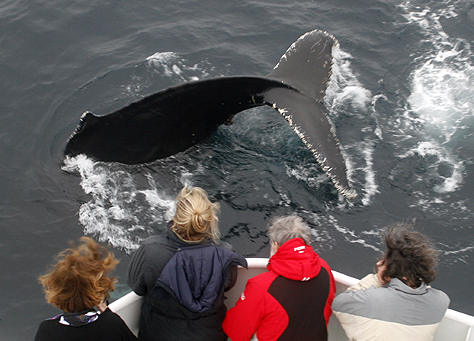 We
had already seen 18 of these when a call went out during dinner that a
small group had been spotted ahead of the ship. Never passing up an opportunity,
we dashed outside just as two of the fabulous creatures rose out of the
water and blew! Over the next hour, as our dinner went cold, we enjoyed
what can only be described as one of the greatest whale watching experiences
ever. The captain stopped the ship and six Humpbacks continually
played within a few feet of our vessel. They could be watched
underwater, rising out, and blowing so close as you could smell their breath.
They kept turning around swimming back to our ship where they rolled around
showing every angle including several much appreciated
tail “fluking”.
We really didn’t care much for our dinner as we had just experienced
one of nature’s most wonderful shows. A fabulous end to another superb
day.
We
had already seen 18 of these when a call went out during dinner that a
small group had been spotted ahead of the ship. Never passing up an opportunity,
we dashed outside just as two of the fabulous creatures rose out of the
water and blew! Over the next hour, as our dinner went cold, we enjoyed
what can only be described as one of the greatest whale watching experiences
ever. The captain stopped the ship and six Humpbacks continually
played within a few feet of our vessel. They could be watched
underwater, rising out, and blowing so close as you could smell their breath.
They kept turning around swimming back to our ship where they rolled around
showing every angle including several much appreciated
tail “fluking”.
We really didn’t care much for our dinner as we had just experienced
one of nature’s most wonderful shows. A fabulous end to another superb
day.
Day 9 - Friday, February 15, 2008
Surrounded by icy mountains, we were already at Cuverville Island before
breakfast. Shortly after breakfast, a shore excursion was made to this
tiny island with a colony of Gentoo Penguins against the backdrop of
several 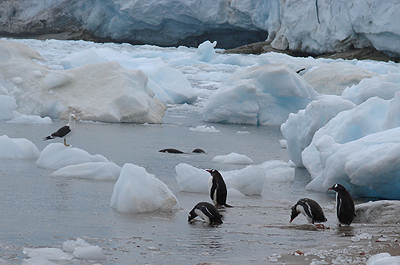 blue icebergs. Once again we could enjoy nice comparisons of
Brown and South Polar Skuas of varying ages and color morphs. Good numbers
of Antarctic Terns flew around and sat on large icebergs.
blue icebergs. Once again we could enjoy nice comparisons of
Brown and South Polar Skuas of varying ages and color morphs. Good numbers
of Antarctic Terns flew around and sat on large icebergs.
Returning back to the ship we were soon cruising to our next destination through the Errera Channel where surface ice increased. We anchored in Andvord Bay, ready for our trip onto mainland Antarctica at Neko Point. The scenery here was truly spectacular with calm waters and flocks of Gentoo Penguins swimming around on the surface. The back drop was countless blue icebergs and huge glaciers that were at the point of calving into the sea. Several Wilson’s Petrels could be watched ‘paddling’ on the surface and one even attempted to land on an iceberg. Two Minke Whales were then spotted cruising through the ice flow, every now and then surfacing, their black bodies looking magical against the white of the ice. At the same time, some of the group got close views of a Leopard Seal laid out on an ice shelf.
As the ship positioned dropped anchor, we all got ready for a landing. The zodiacs worked their way through floating sheet ice to reach shore and once there we could at last say we had set foot on the Antarctic continent proper. The beach here was littered with Gentoo Penguins, a lone Chinstrap, several Brown Skuas, and Kelp Gulls. A large male Antarctic Fur Seal stood guard on a hill above us and the whole atmosphere seemed very special. Across the small bay two avalanches were watched tumbling like waterfalls from the mountain tops and the eerie sound of the glacier cracking had us all watch in anticipation of a huge column ready to calve.
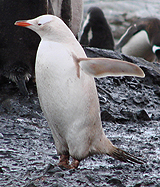 Back on board we dried out and warmed up in the ship’s
bar. Cruising on to another bay we made another landing at a Chilean
Air Base where we were greeted and shown around. The motive for our visit
was however the chance to see a leucistic Gentoo Penguin, one of up to
four that are regular around the station. We soon found it and also got
some really clean looking Snowy Sheathbills. Back on board, we set off
south and headed toward the Lemaire Channel.
Back on board we dried out and warmed up in the ship’s
bar. Cruising on to another bay we made another landing at a Chilean
Air Base where we were greeted and shown around. The motive for our visit
was however the chance to see a leucistic Gentoo Penguin, one of up to
four that are regular around the station. We soon found it and also got
some really clean looking Snowy Sheathbills. Back on board, we set off
south and headed toward the Lemaire Channel.
Day 10 - Saturday , February 16, 2008
This morning we traveled through the narrow entrance to the Lemaire Channel,
a very scenic area comprised of tall snow-capped mountains running sharply
down into the sea. The narrow body of water passing through was scattered
with numerous icebergs. Near the entrance we sighted two Minke Whales,
which we wanted to be Antarctic Minkes, but to secure the identification
meant seeing features that were constantly below the surface. On the
other side of the channel we anchored and later set off on a cruise in
the zodiacs. We checked out the rocky shore where a Weddell Seal peered
at us from a shallow bay and Skuas and Penguins looked somewhat cold
on the bare rocks. An Antarctic Tern decided to follow us low
over our heads and one particular area had an amazing collection of snow
algae making the whole hillside look both red and green. We then took
the zodiacs up close to a variety of beautiful looking icebergs. These
bergs took on a whole new look when we got beside them. The clear
turquoise waters and aqua reflections made for a most memorable trip.
A real highlight was one particular berg that was  hollowed out in the
center allowing us to float inside. The colors and patterns
defied the best of photographers to capture its sheer beauty. This would
have to remain in our memories.
hollowed out in the
center allowing us to float inside. The colors and patterns
defied the best of photographers to capture its sheer beauty. This would
have to remain in our memories.
Leaving this area, we passed back through the Lemaire Channel and continued on to Vernadsky Station. Several good showings of Humpback Whales kept us alert, and later in the day when we witnessed a Humpback repeatedly breaching - yet another truly special moment. At the station we had a short historic tour and saw the actual station where scientists discovered the hole in the ozone layer. We were invited to the bar for a drink of the traditional vodka and heard stories about daily life at the station. A cruise around the coves got us up close to South Polar Skuas, Gentoos, a lone Adelie Penguin and some very interesting mosses. From the shore we watched as a menacing Leopard Seal as it patrolled each and every inlet in search of any unsuspecting prey.
Day 11 - Sunday, February 17, 2008
This morning an hour or so of birding before breakfast had us passing through
the Bransfield Strait where we started off with regular species such
as Wilson’s Storm Petrels, Southern Giant Petrels, Black-browed
Albatross and South Polar Skuas. We were then taken by surprise when
an albatross was spotted by Dick as it sat on the
water right beside the ship. We ran to the port side and watched as a
Light-mantled Sooty Albatross took off and slowly glided alongside giving
superb views. A quick run around to gather up the rest of the group got most of them to see it. Next up we had a few whale
blows ahead of us and soon we were enjoying good views of two
Fin Whales regularly surfacing. More blows were unidentified further
out and then a single Southern Fulmar was spotted among a group of Cape
Petrels.
We then spotted two whales breaking the surface and heading towards the ship. A second view saw a rather tall dorsal fin on two animals that were obviously brown and cream. Based on our views and previous experience, these seemed almost certainly to be Southern Bottle-nosed Whales. This was certainly a very exciting hour and still not over as Dick drew our attention to the first of five Gray-headed Albatrosses, several of which came close in front of the bow. Lots more Black-browed Albatrosses appeared as did a lone Black-bellied Storm-Petrel. Several Humpback Whales gave brief views and another group of whales showed taller dorsal fins than expected on Fin Whales, combined with powerful blows, showing simultaneously with both body and fin. It was highly likely that these were Sei Whales but not conclusive enough to get on our list as anything other than probable. With all this action going on we took a late and quick breakfast followed immediately by a return visit to the observation bridge. Black-browed’s were still showing and Kev had seen a Gray-headed while Anona spotted our first full adult Wandering Albatross of the day. We continued to cruise past Livingstone Island which looked spectacular covered in snow and surrounded by blue sky, apparently quite unusual!
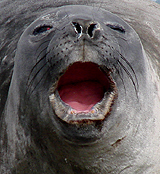 As we approached Robert Point, the expedition crew set off
to check for a safe landing area. It wasn’t long before we all
landed on the pebbly beach where lots of Antarctic Fur Seals and our
first group of Southern Elephant Seals. A short walk around found us
groups of Chinstrap Penguins and Wilson’s
Petrels that must have been nesting in and around the rocky outcrops. More
groups of Southern Elephant Seals were seen lounging around and laying
in the surf, while one of Antarctica’s two flowering plants were
pointed out to us. Finally we got to see one huge male Elephant Seal
with his small harem. We were reluctant to leave this beautiful and tranquil
place but had to move on to our next stop
at Yankee Bay. Enroute, we passed through many ice flows and incredible
icebergs. Once again Humpback Whales were regular with many sightings.
A few Fin Whales were also spotted as well as a variety of birds that kept us
going until dusk.
As we approached Robert Point, the expedition crew set off
to check for a safe landing area. It wasn’t long before we all
landed on the pebbly beach where lots of Antarctic Fur Seals and our
first group of Southern Elephant Seals. A short walk around found us
groups of Chinstrap Penguins and Wilson’s
Petrels that must have been nesting in and around the rocky outcrops. More
groups of Southern Elephant Seals were seen lounging around and laying
in the surf, while one of Antarctica’s two flowering plants were
pointed out to us. Finally we got to see one huge male Elephant Seal
with his small harem. We were reluctant to leave this beautiful and tranquil
place but had to move on to our next stop
at Yankee Bay. Enroute, we passed through many ice flows and incredible
icebergs. Once again Humpback Whales were regular with many sightings.
A few Fin Whales were also spotted as well as a variety of birds that kept us
going until dusk.
Day 12 - Monday, February 18, 2008
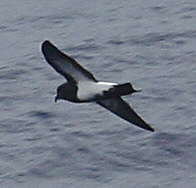 During the night we had crossed into the Drake Passage and the seas had
gone from calm to a large swell. The morning saw us on the bridge from
where we spotted the first of 30+ Soft-plumaged Petrels, a few Black-bellied
Storm-Petrels, Black-browed, and two Gray-headed Albatrosses. Once again
it looked like we started the “Drake” in very good sea condition.
As time went on things changed and the swell increased until the ship
was really “rocking & rolling”. We continued watching
on and off all day. The number of Soft-plumaged Petrels topped 40 and
among them was at least one Blue Petrel, while several Prions defied
specific identification.
During the night we had crossed into the Drake Passage and the seas had
gone from calm to a large swell. The morning saw us on the bridge from
where we spotted the first of 30+ Soft-plumaged Petrels, a few Black-bellied
Storm-Petrels, Black-browed, and two Gray-headed Albatrosses. Once again
it looked like we started the “Drake” in very good sea condition.
As time went on things changed and the swell increased until the ship
was really “rocking & rolling”. We continued watching
on and off all day. The number of Soft-plumaged Petrels topped 40 and
among them was at least one Blue Petrel, while several Prions defied
specific identification.
Day 13 - Tuesday, February 19, 2008
After an interesting night, we were up early and watching
from both the bridge and the stern where species included Wandering,
Black-browed and Gray-headed Albatrosses, Southern Giant Petrel, White-chinned
Petrel, Soft-plumaged Petrel, and a couple of Sooty Shearwaters. As
we neared land, King Cormorants started to appear while numbers of Sooty
Shearwaters reached hundreds and we counted well over 200 Black-browed
Albatrosses. Magellanic Penguins
were now being seen in small groups on the surface and the scenery had become
green forested hills, a far cry from the barren yet scenic ice continent
we had left behind. On our final approach toward the entrance to the Beagle
Channel, we anchored and awaited a pilot to
escort the ship into port. As a finale to our Antarctic cruise, we rushed
to the bow where 20 or so Dusky Dolphins played for twenty minutes
just in front of the ship allowing wonderful views. They could
be seen underwater, leaping out, twisting and turning. This was
the perfect scenario before we had our last dinner on board and recap
of our expedition.
Day 14 - Wednesday, February 20, 2008
This morning we woke with the our ship back in port in Ushuaia. After
breakfast we disembarked and were duly met by Marcello
our local guide. After dropping the luggage off at our hotel we set off
for a full day in Tierra Del Fuego National Park.
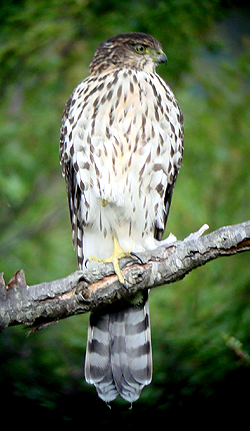 As we made our way
to this stunningly beautiful park, we passed many Chimango Caracaras and
a few Southern Caracaras, plus several groups of Southern Lapwing. Once
inside the park we made a roadside stop and, to our delight, two Andean
Condors flew low overhead. The next stop was right underneath a perched
Southern Caracara which allowed a great opportunity to see its finely
marked plumage and take photos. In the bushes we found a group of
Thorn-tailed Rayaditos, plus Austral Thrush, Patagonian Sierra-Finches,
and an Austral Parakeet that flew quickly past.
As we made our way
to this stunningly beautiful park, we passed many Chimango Caracaras and
a few Southern Caracaras, plus several groups of Southern Lapwing. Once
inside the park we made a roadside stop and, to our delight, two Andean
Condors flew low overhead. The next stop was right underneath a perched
Southern Caracara which allowed a great opportunity to see its finely
marked plumage and take photos. In the bushes we found a group of
Thorn-tailed Rayaditos, plus Austral Thrush, Patagonian Sierra-Finches,
and an Austral Parakeet that flew quickly past.
In a more open area with wonderful views of snow capped mountains, we got superb looks at a Chilean Hawk, perched in a close tree, and great looks at groups of Black-chinned Siskins, Patagonian Sierra-Finches, and several White-crested Elaenias. Down by a river, we watched a Ringed Kingfisher perched on a log and saw a South American Snipe fly over while on the river edge were three Upland Geese. Just as we were going to have a hot drink and some snacks, three Austral Parakeets flew into a tree above us and perched in full view for all to see.
Moving on, shouting erupted on the bus as two huge Magellanic Woodpeckers were spotted on a dead tree. We were soon out and enjoying wonderful views of two males and a female working the nearby trees. This was one of our most wanted target birds in the park and everyone was thrilled that we had found one of the world’s largest woodpeckers.
Continuing on we added Dark-fronted Ground-Tyrants and more of the species already mentioned. Driving down the road toward the sea we spotted two Red Foxes, an adult and a youngster walking along the edge of the road. We saw them again later near a parking lot where the adult Fox was being enticed to food being given out by tourists. A search of the shore yielded Crested Duck and Upland Geese while further out on the water were Magellanic Penguins, Chilean Skuas, King Cormorants, Flightless Steamer-Ducks, lots of South American Terns, some distant Black-browed Albatross, and a few close Rock Cormorants. Leaving here we passed by a pond where a lone Great Grebe was much appreciated as Con had just mentioned possibilities of seeing one just two seconds before!
As we approached our picnic lunch stop we saw another two Great Grebes with a nest, while at the picnic spot we were surprised to see a pair of Chiloe Wigeon with three chicks. After lunch we moved on but hadn’t gone far when three more Magellanic Woodpeckers were spotted right beside the road. We got out and followed them for a half hour into an area where we had the most incredible views you could ever wish for. Nearby we watched Fire-eyed Duicon performing a display flight before plummeting down and perching on an exposed tree top. Our next stop beside a wetland produced more Austral Thrushes, Black-chinned Siskin, Bar-winged Cinclodes, another Fire-eyed Duicon, some Speckled Teal, and Yellow-billed Pintail.
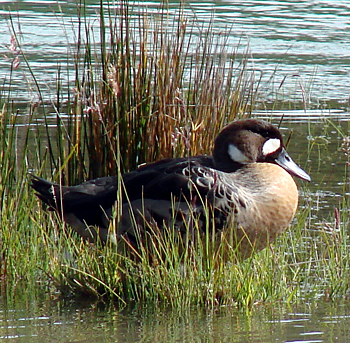 A surprise find by David was a Grass Wren that we managed
several reasonable views of, and according to Marcello, was totally
unexpected and may represent a very good record for the park. A short walk
found us a Black-chested Buzzard Eagle perched high above a cliff but gave
good looks through the scope.
A surprise find by David was a Grass Wren that we managed
several reasonable views of, and according to Marcello, was totally
unexpected and may represent a very good record for the park. A short walk
found us a Black-chested Buzzard Eagle perched high above a cliff but gave
good looks through the scope.
Moving on to a picnic ground set in a forest beside a fast flowing river we saw numerous Chimango Caracaras, plus close views of a Great Grebe, Dark-bellied Cinclodes, and a superb Spectacled Duck. The woodland was alive with many Thorn-tailed Rayaditos and Rufous-collard Sparrows, but we needed to try another woodland area before we got lucky with a White-throated Treerunner. Along the same trail we eventually heard an Austral Pygmy-Owl and after quite a search, we pinned it down to the very top of a tree. We enjoyed great views as it was mobbed by a flock of White-crested Elaenias and Patagonian Sierra-Finches. Our final bird of the day was going to be difficult but eventually we heard one call and Gina spotted movement beside a dead tree. We patiently waited and were rewarded with brief, good views of a skulky Magellanic Tapaculo! This ended our superb day in Tierra del Fuego National Park and indeed our adventure to Antarctica.
Day 15 - Thursday, February 21, 2008
This morning we had a little free time before setting
off to Ushuaia Airport. Some went birding down by the shore seeing a
wealth of good birds and Kev staked out a Muskrat eventually seeing
it in a small vegetation covered pool. Once at the airport we began our
journeys back to the U.S. or U.K. and concluded a wonderful
tour.
It was a pleasure to lead this tour with so many keen birders and wildlife enthusiasts. Many thanks go to all who participated on the trip which was great fun and an overall fantastic experience.
Steve & Gina
